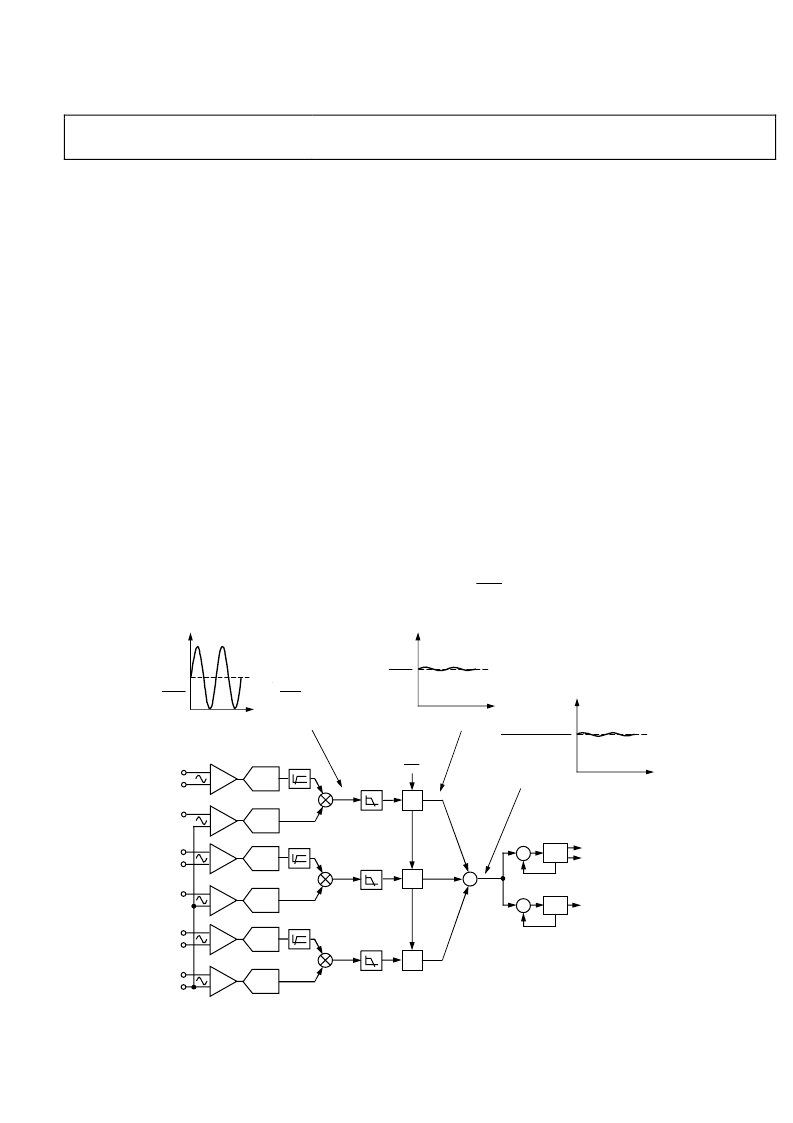- 您現(xiàn)在的位置:買(mǎi)賣(mài)IC網(wǎng) > PDF目錄373980 > ADE7752B (Analog Devices, Inc.) Polyphase Energy Metering IC with Pulsed Output PDF資料下載
參數(shù)資料
| 型號(hào): | ADE7752B |
| 廠商: | Analog Devices, Inc. |
| 英文描述: | Polyphase Energy Metering IC with Pulsed Output |
| 中文描述: | 多相電能計(jì)量IC脈沖輸出 |
| 文件頁(yè)數(shù): | 13/27頁(yè) |
| 文件大?。?/td> | 342K |
| 代理商: | ADE7752B |
第1頁(yè)第2頁(yè)第3頁(yè)第4頁(yè)第5頁(yè)第6頁(yè)第7頁(yè)第8頁(yè)第9頁(yè)第10頁(yè)第11頁(yè)第12頁(yè)當(dāng)前第13頁(yè)第14頁(yè)第15頁(yè)第16頁(yè)第17頁(yè)第18頁(yè)第19頁(yè)第20頁(yè)第21頁(yè)第22頁(yè)第23頁(yè)第24頁(yè)第25頁(yè)第26頁(yè)第27頁(yè)

Preliminary Technical Data
ADE7752B
THEORY OF OPERATION
The six signals from the current and voltage transducers are
digitized with ADCs. These ADCs are 16-bit second-order ∑-Δ
with an oversampling rate of 833 kHz. This analog input
structure greatly simplifies transducer interface by providing a
wide dynamic range and bipolar input for direct connection to
the transducer. High-pass filters in the current channels remove
the dc component from the current signals. This eliminates any
inaccuracies in the active power calculation due to offsets in the
voltage or current signals (see the HPF and Offset Effects
section).
Rev. PrA | Page 13 of 27
The active power calculation is derived from the instantaneous
power signal. The instantaneous power signal is generated by a
direct multiplication of the current and voltage signals of each
phase. In order to extract the active power component, the dc
component, the instantaneous power signal is low-pass filtered
on each phase. Figure 15 illustrates the instantaneous active
power signal and shows how the active power information can
be extracted by low-pass filtering the instantaneous power
signal. This method is used to extract the active power
information on each phase of the polyphase system. The total
active power information is then obtained by adding the
individual phase active power. This scheme correctly calculates
active power for nonsinusoidal current and voltage waveforms
at all power factors. All signal processing is carried out in the
digital domain for superior stability over temperature and time.
The low frequency output of the ADE7752B is generated by
accumulating the total active power information. This low
frequency inherently means a long accumulation time between
output pulses. The output frequency is therefore proportional to
the average active power. This average active power information
can, in turn, be accumulated (for example, by a counter) to
generate active energy information. Because of its high output
frequency and therefore shorter integration time, the CF output
is proportional to the instantaneous active power. This pulse is
useful for system calibration purposes that would take place
under steady load conditions.
POWER FACTOR CONSIDERATIONS
Low-pass filtering, the method used to extract the active power
information from the individual instantaneous power signal, is
still valid when the voltage and current signals of each phase are
not in phase. Figure 16 displays the unity power factor
condition and a displacement power factor (DPF) = 0.5, that is,
current signal lagging the voltage by 60°, for one phase of the
polyphase. Assuming that the voltage and current waveforms
are sinusoidal, the active power component of the instantaneous
power signal (the dc term) is given by
×
60
cos
2
(
)
°
×
1
V
(1)
TIME
IAP
IAN
VAP
HPF
LPF
IBP
IBN
VBP
ICP
ICN
VCP
VN
DIGITAL-TO-
FREQUENCY
DIGITAL-TO-
FREQUENCY
F1
F2
CF
INSTANTANEOUS
ACTIVE POWER SIGNAL
INSTANTANEOUS
POWER SIGNAL - p(t)
INSTANTANEOUS
TOTAL
POWER SIGNAL
VA × IA + VB × IB +
VC × IC
2
ABS
|X|
Σ
Σ
Σ
LPF
LPF
|X|
|X|
p(t) = i(t) ×v(t)
WHERE:
v(t) = V × cos (
ω
t)
i(t) = I × cos (
ω
t)
p(t) = V × I
2
{1+ cos (2
ω
t)}
V × I
2
V × I
V × I
2
MULTIPLIER
MULTIPLIER
MULTIPLIER
HPF
HPF
ADC
ADC
ADC
ADC
ADC
ADC
0
Figure 15. Signal Processing Block Diagram
相關(guān)PDF資料 |
PDF描述 |
|---|---|
| ADE7752BARW | Polyphase Energy Metering IC with Pulsed Output |
| ADE7752BARW-RL | Polyphase Energy Metering IC with Pulsed Output |
| ADE7752BARWZ | Polyphase Energy Metering IC with Pulsed Output |
| ADE7752BARWZ-RL | Polyphase Energy Metering IC with Pulsed Output |
| ADE7753 | Active and Apparent Energy Metering IC with di/dt sensor interface |
相關(guān)代理商/技術(shù)參數(shù) |
參數(shù)描述 |
|---|---|
| ADE7752BARW | 制造商:AD 制造商全稱:Analog Devices 功能描述:Polyphase Energy Metering IC with Pulsed Output |
| ADE7752BARW-RL | 制造商:AD 制造商全稱:Analog Devices 功能描述:Polyphase Energy Metering IC with Pulsed Output |
| ADE7752BARWZ | 功能描述:IC ENERGY METERING 3PHASE 24SOIC RoHS:是 類(lèi)別:集成電路 (IC) >> PMIC - 能量測(cè)量 系列:- 產(chǎn)品培訓(xùn)模塊:Lead (SnPb) Finish for COTS Obsolescence Mitigation Program 標(biāo)準(zhǔn)包裝:2,500 系列:* |
| ADE7752BARWZ-RL | 功能描述:IC ENERGY METERING 3PHASE 24SOIC RoHS:是 類(lèi)別:集成電路 (IC) >> PMIC - 能量測(cè)量 系列:- 產(chǎn)品培訓(xùn)模塊:Lead (SnPb) Finish for COTS Obsolescence Mitigation Program 標(biāo)準(zhǔn)包裝:2,500 系列:* |
| ADE7753 | 制造商:AD 制造商全稱:Analog Devices 功能描述:Active and Apparent Energy Metering IC with di/dt sensor interface |
發(fā)布緊急采購(gòu),3分鐘左右您將得到回復(fù)。